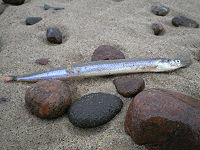
Photo from wikipedia
In the North Sea, the number and size of offshore wind (OW) turbines, together with the associated network of High Voltage Direct Current (HVDC) subsea cables, will increase rapidly over… Click to show full abstract
In the North Sea, the number and size of offshore wind (OW) turbines, together with the associated network of High Voltage Direct Current (HVDC) subsea cables, will increase rapidly over the coming years. HVDC cables produce magnetic fields (MFs) that might have an impact on marine animals that encounter them. One of the fish species that is at risk of exposure to MF associated with OW is the lesser sandeel (Ammodytes marinus), a keystone species of the North Sea basin. Lesser sandeel could be exposed to MF as larvae, when they drift in proximity of OW turbines. Whether MFs impact the behavior of lesser sandeel larvae, with possible downstream effects on their dispersal and survival, is unknown. We tested the behavior of 56 lesser sandeel larvae, using a setup designed to simulate the scenario of larvae drifting past a DC cable. We exposed the larvae to a MF intensity gradient (150-50 μT) that is within the range of MFs produced by HVDC subsea cables. Exposure to the MF gradient did not affect the spatial distribution of lesser sandeel larvae in a raceway tank 50 cm long, 7 cm wide and 3.5 cm deep. Nor did the MF alter their swimming speed, acceleration or distance moved. These results show that static MF from DC cables would not impact behavior of lesser sandeel larvae during the larval period of their life although it does not exclude the possibility that later life stages could be affected.
Journal Title: Marine environmental research
Year Published: 2022
Link to full text (if available)
Share on Social Media: Sign Up to like & get
recommendations!